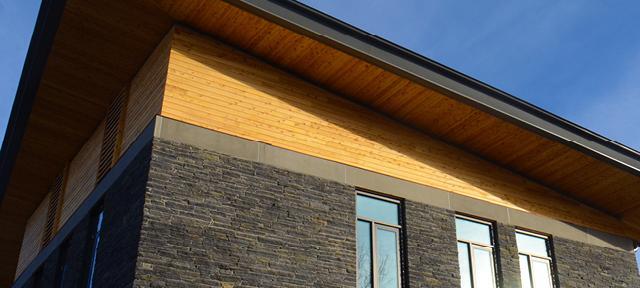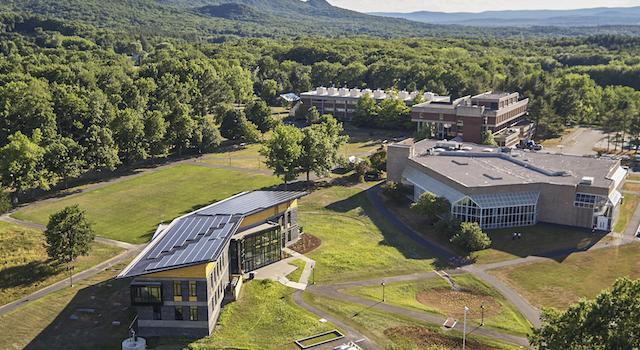Hampshire Announces Ribbon-Cutting Opening Ceremony for Kern Center

The countdown to the opening ceremony for the R.W. Kern Center has begun, as Hampshire is now finalizing plans for the building’s official ribbon-cutting on Friday April 29, 2016.
In attendance at the 10:30am ceremony for the campus community will be principal Kern Center donors; Hampshire students, faculty, and staff; college trustees; and partnering architects, builders, and suppliers. The college is also planning a larger dedication ceremony the second week of September to feature national environmental leaders and an educational symposium (final date pending).
The R. W. Kern Center is a living symbol of Hampshire’s values in practice and ideas in action. The college’s first new building in three decades, it was built with the goal of becoming only the ninth building certified under the world’s most rigorous green building standard, the Living Building Challenge (LBC): operating net-zero energy, water, and waste; built using materials mainly from local and regional sources; and avoiding toxic “red list” materials, right down to the duct tape allowed on site.
The project has been featured by many media outlets including most recently The Boston Globe last Sunday.
The Center will house the offices of admissions and financial aid, classrooms, student lounges and social areas, and a coffee bar. It was also built as a living laboratory for ongoing studies of the building and its systems. Its $10.4 million project cost was made possible by private donations.
The Kern Center is one of the major projects of Hampshire’s broad sustainability initiative. The college has committed to making campus operations carbon neutral by 2020, and is also planning for the campus to go 100 percent solar this year.
“With this building we have sought to reflect our values, in the inclusive design process, the design and materials, our construction practices, and our reporting about the building,” said President Jonathan Lash. “Why are buildings constructed any other way? In every way, the Kern Center was built to learn and teach.”
In the planning process that began in 2012, three students served alongside faculty and staff as members of the project planning committee: Wesley Evans, Hester Tittman, and Dominique White. In addition, all Hampshire students were invited to multiple planning meetings and dialogues over many months, to provide feedback on the building’s purpose and design.
Hampshire fourth-year student Wesley Evans said he, Tittmann, and White saw their role as stewards of input from students, inviting their peers into the process and putting them in contact with the architects. “The architects spent hundreds of hours with faculty, students, and staff, listening,” Evans said. “What types of spaces do we need to be successful? What does a classroom look like for the next generation of Hampshire? That’s a big question, we spent a lot of time grappling with that.”
Dominique White said she is proud that she and many other students advocated for themselves, speaking out against decisions that would have been detrimental to student use of the center, and proposing and supporting ideas that were better for the campus at large. “I hope students recognize how much care and attention went into representing our community’s voices in the design,” White said. “There were so many public dialogues, and so many of us had a say in its planning.”
Evans said the planning process peaked when five architecture firms were invited to campus to present models of what the Kern Center could be in open meetings to the community. “I’ve seen grilling before, but these architects just got peppered,” he said. “Intelligent questions—and follow-ups to the follow-ups. It’s been a powerful learning opportunity.”
With the building under construction this academic year, the Kern Center has already been the focus of multiple science and technology courses. It has been designed to facilitate and inspire education for its lifetime.
Dominique White said serving on the committee offered an opportunity for her to be mentored by the architects and the Kern Center’s builder, Jonathan Wright of Wright Builders in Northampton, Mass., a Hampshire alum. As a student with a concentration in architecture, and now as an alum working full-time in the College’s admissions office, White said she has to continually remind people the center is not a LEED building. “There’s so much more to it, it has so many green building systems. I love that Hampshire is the starter of dialogues and influencer of changes, from the way we consume food to the way we look at buildings. I hope the building continues influencing change on campus and influencing students in their studies.”
“I’m really proud of it, I brag about it to my family and friends who go to other colleges with castle-y buildings,” White added. “We have a living building. It’s pretty cool.”
Hampshire alum Jonathan Wright said his building business was transformed by the experience of constructing its first LBC building, even after having built 34 LEED-certified projects in his career.
“As a consequence of working on the R.W. Kern Center, never again can I smell plastic pipe solvents, PVC, or wood-finish fumes without knowing the losses to those who make and handle the products, without choosing nontoxic products instead. Never again can I see a building product without asking where and how it’s made, who made it, how far it traveled, and verifying its claims. Never again can I propose a building without planning how to reduce its carbon impact.”
The project also transformed the work of the building’s architects, Jason Forney and Jason Jewhurst of Bruner/Cott Architects & Planners of Cambridge, Mass. “The LBC challenges us to stop focusing on making buildings that are merely less bad, and to ask instead, ‘What does good look like?’” they said in a joint statement. “Good design starts with net positive energy, net positive water, materials that are safe for humans, designs that favor people (not cars), healthy indoor environments, and innate connections to nature. Responding to Hampshire’s call to action through design is the kind of work that stirs passion. This is why we became architects.”
A number of anticipated Kern Center highlights and features will be unveiled this year, including a large-screen digital dashboard developed by faculty and students displaying performance of the building’s systems in real-time. In addition, Assistant Professor of Computer Science and Game Design Ira Fay is developing a series of original puzzles for embedding in the center’s interior, as permanent installations. (The College cannot announce when the puzzles will be installed this year for play, as visitors will be challenged to discover the puzzle themselves, and to try and solve them.)
R.W. KERN CENTER BUILDING COMMITTEE
STUDENTS
Wesley Evans
RJ Sakai
Hester Tittman
Dominique White
FACULTY/ACADEMIC AFFAIRS
Gabriel Arboledo
Myrna Breitbart
Sue Darlington
Yaniris Fernandez
Michael Klare
John Slepian
Tim Zimmerman
STAFF
Larry Archey
Carolyn Arnold
Tom Davies (Amherst College)
Renee Friedman
Beth Hooker
Doreen Kamansky
Nancy Karella
Maureen McCarthy
Jessica M. Ortiz
Eric Vettese
Carl Weber
OFFICE OF THE PRESIDENT, TRUSTEES, DIVISION HEADS
Clay Ballantine
Gaye Hill
Jonathan Lash
Mary McEneany
Joanna Olin
Julie Richardson
Ken Rosenthal
Mark Spiro
Meredith Twombly



